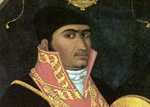José María Morelos
(1765-1815)
 |
|---|
Hero of Mexican Independence
FIRST PHASE OF MORELOS' LIFE
1765 José
María Morelos y Pavón was born in
1790 Morelos attended the Colegio de
San Nicolás in Valladolid. The
director or headmaster of this school was none other than Miguel Hidalgo.
1795 Morelos
went to
1795-1797 He
studied religion and was ordained a subdeacon, deacon, and presbyter. He then
earned his living as a teacher or tutor and as a parish priest.
1798 As
an interim parish rector he supported his mother and sister.
1798-1810 He
lived as the parish priest and rector in San Agustín Carácuaro.
SECOND
PHASE OF MORELOS' LIFE
1810-1815 Morelos
led four campaigns at the head of the rebel Mexican army.
1810 Shortly
after
1810-1812 Years
of Morelos' first campaign.
He
recruits 3,000 men at arms dedicated to fight for independence, and they engage
in several battles.
At
the end of this campaign he conquers
1811 He
engages in many battles with his companions and with Hermenegildo Galeana.
Together they achieve a string of victories: they defeat the royalist forces in París, Cosío,
and Fuentes, thereby controlling the entire state of Guerrero.
1812 Years of Morelos' second campaign
The
Spanish viceroy Venegas concentrates the Spanish army in
Meanwhile
Morelos' forces occupy
1812-1813 Years
of Morelos' third campaign
Morelos
reorganizes his army with 5,000 men, and he marches on
The
next year he reoccupies
In
1813, the National Constitutional Congress (Congreso Nacional Constituyente)
meets in
On
November 6, 1813, Morelos signs the Acta Solemne de la Declaración de
Independencia de América Septentrional (Declaration of Independence of North
America).
1813-1815 Years
of Morelos' fourth and last campaign.
1813 Morelos
arrives at Valladolid with a force of 5,000 men, but Agustín de Iturbide, the
general in charge of the Spanish royal forces, attacks Morelos' encampment and
defeats Morelos' insurgent army.
1814 Morelos'
brigade commander,
Late
this year Morelos attends the insurrectionist congress in order to complete the
constitutional degree declaring freedom for "Mexican America" (la América
mexicana).
1815 (May)
Morelos once again flees from Iturbide.
(September)
The freedom fighters escape to Tehuacán.
(November
3) Morelos is captured by Iturbide's forces.
(December)
Morelos, as a priest, is jailed by the Inquisition in
(December
22) Morelos is executed by the Spanish troops under the viceroy's authority. Morelos
is interred in the Catedral Metropolitana at the heart of
Morelos is considered by Mexicans and by
Mexican historians as one of the two main heroes of Mexican independence.


